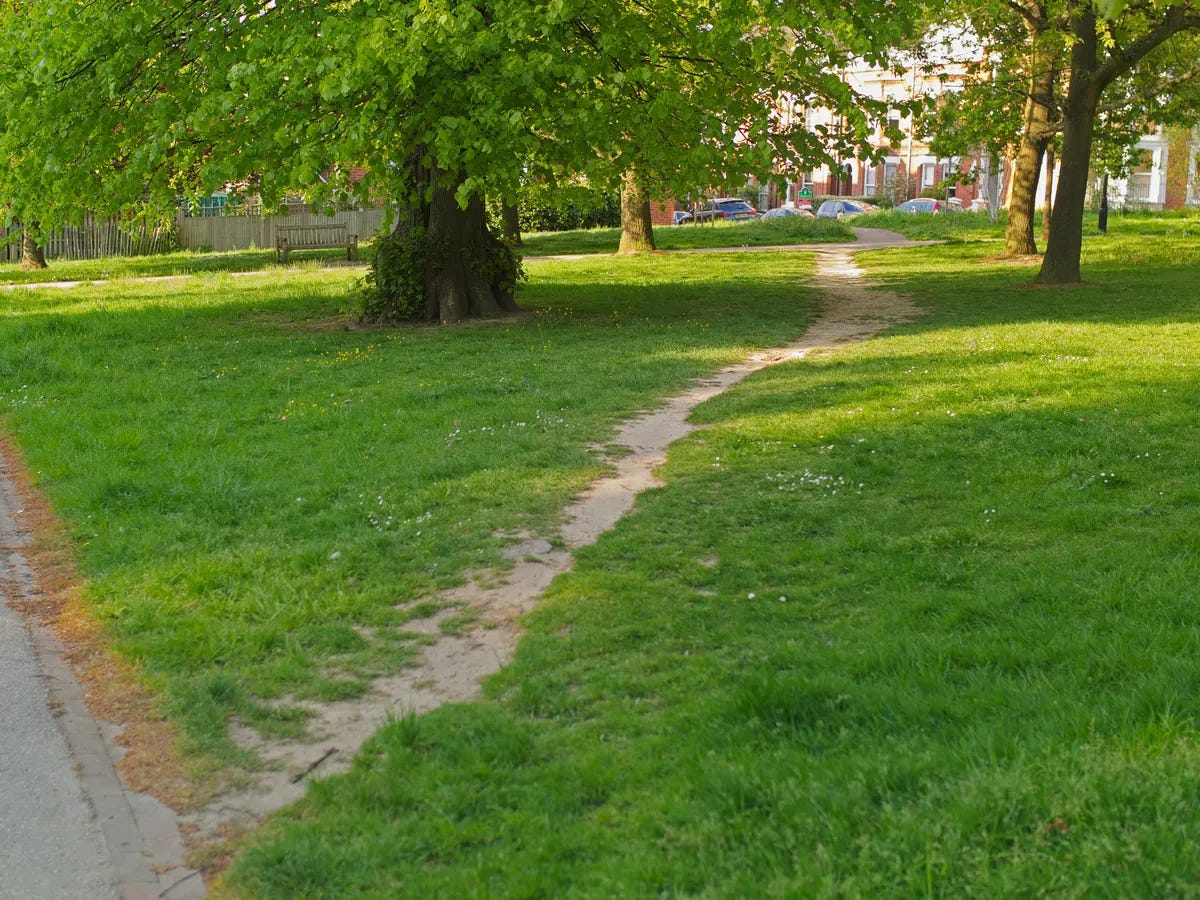Desire Paths and Loneliness.
The Intersection of Human Yearning and Solitude.
Desire paths, also known as desire lines or social trails, are informal paths created by individuals who choose to stray from established routes and sidewalks to take more direct and convenient paths to their destinations. These paths often emerge naturally over time due to repeated usage by people seeking more efficient ways to navigate their surroundings. While desire paths represent a physical manifestation of human yearning and determination, they also provide a fascinating lens through which we can explore the complex relationship between desire, human interaction, and loneliness.
Desire paths are a testament to human ingenuity and adaptability. They reflect the collective will of individuals to forge their own way, breaking free from prescribed routes and structures. The allure of desire paths lies in their spontaneity and authenticity. Each desire path represents a small act of defiance against established norms, symbolizing the human spirit's desire for autonomy and self-expression. In this context, desire paths can be seen as a manifestation of the longing for freedom and the refusal to be confined by predefined boundaries.
The creation of desire paths often stems from the shared needs and preferences of a community or group of individuals. As multiple people choose the same alternative route, these paths naturally evolve into well-trodden trails. Desire paths, therefore, offer insight into the communal nature of human behavior and the subtle ways in which societies can influence the physical landscape. The act of walking a desire path can foster a sense of camaraderie and connection among strangers, as they collectively navigate a route that challenges the status quo.
While desire paths illustrate the power of collective action and communal decision-making, they also raise questions about individuality and the desire for authentic connection. The act of deviating from the prescribed route can be seen as an expression of personal choice and self-reliance. However, it can also be viewed as a metaphor for the human yearning for a deeper sense of connection and belonging. The decision to take a desire path may be driven by a longing to escape the sense of isolation that comes from following the mainstream, seeking instead to forge a unique path that aligns with one's true desires.
Ironically, desire paths can coexist with a profound sense of loneliness. As individuals deviate from conventional routes and venture onto their own paths, they might feel isolated or disconnected from the collective. The act of walking a desire path can be a solitary experience, even amidst a crowd of people. This paradox highlights the complexity of human emotions, where the pursuit of individuality and autonomy can sometimes lead to feelings of loneliness and detachment.At the same time, desire paths can offer solace to those who feel alienated by the demands of society. By taking an alternative route, individuals reclaim a sense of agency over their lives, finding comfort in the act of following their own instincts rather than conforming to societal norms. The desire path becomes a refuge, a place where one's true self can be expressed freely without judgment or restraint. In this sense, desire paths can be seen as a source of empowerment and a means of overcoming the burden of loneliness by embracing one's uniqueness.
Desire paths are not just physical trails; they symbolize the indomitable human spirit and the longing for authenticity and connection. While these paths may emerge from collective needs and actions, they also provide a window into the human desire for individuality and autonomy. However, the pursuit of individuality can sometimes lead to feelings of loneliness amidst the crowd. Despite this, desire paths offer solace and empowerment, becoming a means to break free from societal constraints and embrace one's true self. In the intersection of desire paths and loneliness, we discover the intricacies of human yearning, resilience, and the eternal quest for genuine human connection.
Hi, thank you so much for reading. Sorry it may not be up to my usual standards, having to work on my phone to write as my laptop is dead!! Fancy buying me a coffee? That would be so awesome if you could and would help my work towards a new laptop.





This reminded me of the story about the design of UC Irvine. The founding chancellor, Dan Aldrich, had the circular center of the campus ringed by a paved path but no paved paths were placed crosswise so that the first and subsequent students could create their own paths (from building to building). The perfect metaphor for what all college student should do.
I never knew what these were called. So fascinating to think about this as a figurative concept. It makes me think of “A Room of One’s Own” when Woolf (or her imagined narrator) strays from the path only to be placed back on it by the Beadle. And then of course there is Frost and “The Road Not Taken.” These aren’t merely bifurcations here but do offer this sense of choice.
Thanks so much for this. I shall keep pondering it and try to experience one soon!